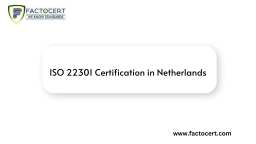

The Ultimate Guide To ISO 22301 Certification Process

Earning ISO 22301 certification is a process that involves meeting certain standards and guidelines developed by the International Organization for Standardization (ISO). To become ISO 22301 certified, organisations must go through a rigorous pre-certification review and then successfully complete an onsite assessment. This article covers all the aspects of ISO 22301 certification, from pre-certification requirements to the onsite assessment.
Understand Business Continuity and ISO 22301 Requirements
Before beginning the certification process, it is important to ensure that your organisation understands the business continuity requirements outlined by ISO 22301. This includes developing a plan for managing risks and disruption, as well as an organisational policy for emergency preparedness and response. Additionally, you must understand the roles of different personnel within business continuity management, identify potential risks or threats to operations, and develop strategy related to each of these.
Implement Risk Management and Business Impact Analysis
Before the ISO 22301 certification process can begin, it is essential that organisations implement risk management and business impact analysis. Risk management is the process of identifying potential risks and threats to operations, assigning ownership internally, and finding ways to reduce or mitigate any risks. Business Impact Analysis (BIA) is then used to determine how potential risks or threats may affect operations, prioritise measures in order to achieve long-term success, and anticipate any disruptions that may occur. This helps organisations develop comprehensive strategies for business continuity in preparation for certification.
In order to become certified, organisations must understand the inputs and outputs of both risk management and business impact analysis, document current operations that may be affected by potential risks or threats, determine which processes are key to continuing operations, provide reasonable continuity plans and strategies, and conduct tests on their business continuity systems. These steps provide organisations with the confidence of knowing that they have an adequate security system in place and adhere to international standards. ISO 22301 certification is evidence of a rigorous implementation of successful risk management and BIA protocols that ensure organisational resilience through any disruptions.
Understand the requirements of ISO 22301
It is important to understand the requirements of ISO 22301 so that organisations can adequately prepare for certification. Organisations should consider their current state and understand what is needed to achieve a compliant system – including the organisation’s own objectives, needs, and expectations. Additionally, organisations should develop and implement procedures for identifying risks and opportunities, primary processes or activities affected by the organisation’s performance, monitoring criteria and performance measures.
Test & Review Readiness in Accordance with ISO 22301
After the business impact analysis and risk assessment processes have been completed, the organisation can now test how ready they are for certification. During this scrutiny process, all the details related to secondary or backup operations should be discussed and agreed upon. The readiness review should include at least one business continuity exercise that puts the plans into action and allows for feedback from all areas of the business. This helps to ensure that any issues can be addressed quickly in order to meet ISO 22301 standards.
After the readiness review and testing has been completed, it’s time to review any aspect of an organisation’s business continuity program that might need refinement prior to certification. This includes further product or process reviews, staff training and development, incident response planning, or other changes needed to bring the organisation in line with ISO 22301 requirements. Once any problems have been noted and resolved, then it should be ready for its final certification audit.
Prepare an Effective Internal Audit Program & Manage Documented Information
For effective ISO 22301 certification, organisations need to have an internal audit program that is reviewed and assessed annually. Internal audits help organisations identify potential opportunities for improvements and provide assurance that the plans are being conducted as expected. To supplement the audit process, documented information should also be effectively managed. This includes establishing processes for reviewing, updating and validating existing documents in order to ensure data accuracy and consistency.
One specific area for organisations to review is the business continuity plan. It should be checked for alignment with the organisation’s objectives and updated on a regular basis. It should also include a list of identified risks, an assessment of the impact of each risk and a strategy which includes preventive measures, corrective actions and response plans in case the worst-case scenario happens. By ensuring that this information is up-to-date and robust, organisations are one step closer to ISO 22301 certification.
